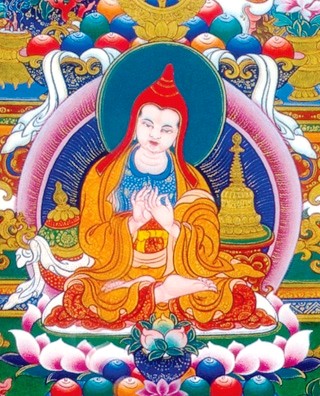Atisha: Difference between revisions
mNo edit summary |
mNo edit summary |
||
| Line 12: | Line 12: | ||
==Main Disciples== | ==Main Disciples== | ||
Chief among Atisha's Tibetan disciples were the three known as "Khu, Ngok, and Drom," who were renowned as emanations of the three main bodhisattvas--[[Avalokiteshvara]], [[Manjushri]], and [[Vajrapani]]: [[Khutön Tsöndru Yungdrung]], [[Ngok Lekpé Sherap]] and [[Dromtön Gyalwé Jungné]]. | Chief among Atisha's Tibetan disciples were the three known as "Khu, Ngok, and Drom," who were renowned as emanations of the three main bodhisattvas--[[Avalokiteshvara]], [[Manjushri]], and [[Vajrapani]]: [[Khutön Tsöndru Yungdrung]], [[Ngok Lekpé Sherap]] and [[Dromtön Gyalwé Jungné]]. | ||
==Further Reading== | |||
*'Atisha's Journey to Tibet', Hubert Decleer, in ''Religions of Tibet in Practice'', edited by Donald S. Lopez Jr., Princeton University Press, 1997 | |||
==External Links== | ==External Links== | ||
Revision as of 20:21, 20 June 2007

Atisha Dipamkara Shrijñana (982-1054) was a great Indian master and scholar, and author of many text including the Lamp for the Path of Awakening. One of the main teachers at the famous university of Vikramashila, he was also a strict follower of the monastic rule and was widely acclaimed for the purity of his teaching. He spent the last ten years of his life in Tibet, teaching and translating texts, and was instrumental in reinvigorating Buddhism there after a period of persecution. His disciples founded the Kadampa school.
Biography
Ga Rabjampa Kunga Yeshe writes:
- The details of Atisha’s life can be learned from the extensive biographies, but here is a brief summary. He was born as the son of Kalyana Shri, the king of Zahor, and immediately upon his birth he had a vision of Noble Tara. From an early age he studied the five sciences and especially the four classes of tantra, so that he became supremely learned. He served in the proper way his learned and accomplished teachers, who included Shantipa, Serlingpa, and Rigpé Khujuk (rigs pa’i khu byug). From the moment he first received the Hevajra empowerment from his guru Rahulagupta, he had visions of many yidam deities. He mastered unimaginable kinds of samadhi meditation. In accordance with prophecies he had received from several masters and yidam deities, directly and in dreams, he took ordination in the Mahasanghika tradition. He gained clairvoyance and miraculous abilities and subjugated demons and tirthika extremists. He received instructions on mind training from the gurus mentioned above and from his yidam deities, and twofold bodhichitta flooded his mind, expanding like a river in summertime.
- In particular, when he realized that the great master of Suvarnadvipa was a perfect embodiment of the bodhichitta teachings, he travelled to Sumatra to seek his instruction. When they met he immediately recognized him as his teacher from former lives and felt boundless devotion. The guru offered him a golden statue [of the Buddha] that he had found in the forest as a child, signifying his empowerment as the holder of his teachings. Atisha spent twelve years receiving instructions, all the while staying close to his guru, and the bodhichitta of cherishing others above oneself was born in his mind.
- He returned to India and became an elder at Vikramashila Monastery. From there his enlightened activity spread in all directions, East and West. He was revered as a master by followers of all schools without any sectarian bias, and he caused the teachings of sutra and mantra to spread far and wide through teaching and through practice. His yidam deities, such as Tara and Kasarpani, and many of his teachers, such as Rahula, told him how beneficial it would be if were to travel to Tibet, and especially how it would benefit a certain lay practitioner, or upasika, and cause the teachings of his oral lineage to flourish. He also received several invitations from the nephew of Lha Lama Yeshe Ö [i.e., Changchub Ö] who had himself been prophesied by the Buddha. So it was that he went to Tibet, where he took pity on the ignorant Tibetans and eradicated their mistaken views and practices through scriptural authority and logical reasoning, thereby setting them upon the genuine path. He caused the torch of the sacred Dharma to blaze, burning away the thickets of mistaken views. He developed people’s minds so that they could see the nature of reality, and he showed clearly the distinction between Dharma and non-Dharma. In the fertile minds of his fortunate disciples, he planted the seeds of bodhichitta and watered them with the finest nectar-like explanations, so that they ripened into the wonderful harvest of liberation. For his foremost heir, the great Dromtönpa in particular, he filled the fine mansion of his intellect with gems of transmission and realization. As if opening up the treasure chest of his precious oral lineage, he dispelled the spiritual poverty of the Land of Snows by bringing bountiful riches of virtue and goodness. Thus, we should know that the glorious Atisha, holder of this precious oral lineage of which is like a chain of golden mountains, was even kinder to us Tibetans than the Buddha himself.
Main Disciples
Chief among Atisha's Tibetan disciples were the three known as "Khu, Ngok, and Drom," who were renowned as emanations of the three main bodhisattvas--Avalokiteshvara, Manjushri, and Vajrapani: Khutön Tsöndru Yungdrung, Ngok Lekpé Sherap and Dromtön Gyalwé Jungné.
Further Reading
- 'Atisha's Journey to Tibet', Hubert Decleer, in Religions of Tibet in Practice, edited by Donald S. Lopez Jr., Princeton University Press, 1997